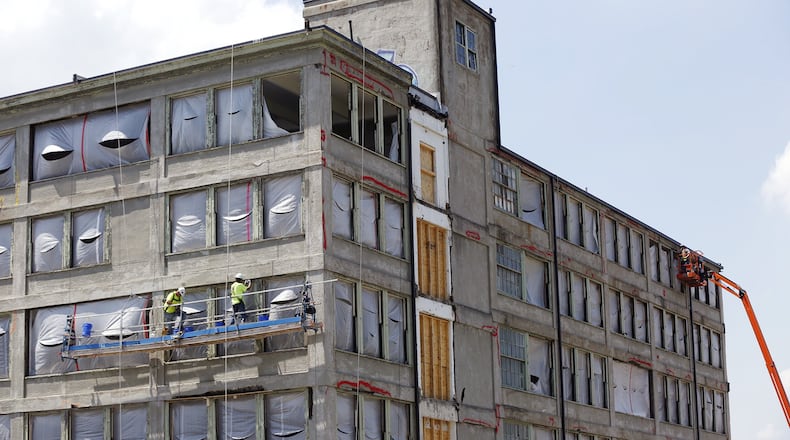“This building represents a rich part of Dayton’s history that hasn’t been told for a long time,” said Mary Kate Lindsey, project manager with developer Weyland Ventures.
The $18.2 million rehab will build on the momentum from the developer’s last Dayton project, the Wheelhouse, which brought new housing, dining and commercial space to the Oregon District area.
MORE:Search of local NASIC contractor looked for 'co-conspirators'
Kentucky-based Weyland Ventures won Ohio historic tax credits for both projects, which are highly competitive and sought-after incentives.
So far, however, only about five Dayton projects to win state historic tax incentives have been completed, which underscores the difficulty and large expense of rehabbing historic structures.
Tony Kroeger, Dayton’s planning manager, said the handful of completed historic renovation projects has been “huge.” They fill empty buildings and display the city’s character and fabric, he said.
“It’s what makes Dayton, Dayton,” he said.
Modern offices for historic building
Nearly a year ago, the Dayton Daily News first reported that the Ohio Development Services Agency had allocated $1.8 million in state historic tax credits to support the renovation of the 80,000-square-foot Motor Car building.
Weyland Ventures proposed converting the building in the Oregon District neighborhood into modern offices for high-tech, creative design and other firms and users.
Rehab work began last month, and Gosiger, a machine tool and robotics automation firm at 108 McDonough St., will lease the first two floors of the six-story building.
Miller-Valentine has partnered with Weyland Ventures on the project, and Apex Commercial Group will handle leasing for the building’s remaining four floors, which are about 12,500 square feet each, with the ability to subdivide each floor.
“The renovation of the Dayton Motor Car Building enables our family business to continue to grow and expand in our current location while, at the same time, taking part in the revitalization of our neighborhood,” Jerry Pressel, Gosiger chief financial officer, said in a statement.
Building part of historic district
Built around 1875, the iconic Dayton Motor Car Building originally housed a farm implement center and later produced automobiles, including the Stoddard-Dayton Motor Car.
The building is part of the Dayton Motor Car Company Historic District, which was named to the National Register of Historic Places in 1984.
The building’s concrete structure, open floor plates and expansive windows make it ideal for office tenants looking for a contemporary space with plenty of natural light, Miller-Valentine said.
“We look forward to contributing to Dayton’s renaissance by attracting creative and new office tenants to this project,” said Tony Witt, principal of Apex Commercial Group.
MORE: 'You've got to live by what you make': Crown Equipment grows company in West Central Ohio.
Miller-Valentine said it will restore the original windows and the exterior of the building and will run the mechanical, electrical and plumbing systems through the floors to leave the ceilings exposed. Antique fire doors will be re-purposed throughout the interior.
The project is expected to be completed during the first quarter of 2020.
Oregon East working master plan
The Motor Car building is an important part of Oregon East — which is a working master plan concept anchored by Weyland Ventures’ developments and Gosiger’s campus, said Lindsey.
The plan is to bridge the “character, charm and amenities” of the Oregon District across Wayne Street and build a new district offering new residential, retail and commercial options, Lindsey said.
“We are working with neighbors, including the Oregon District Business Association and the city of Dayton, to define this idea and create a long-term vision for a dense, active, pedestrian-friendly, mixed-use neighborhood,” she said.
Weyland Ventures and Miller-Valentine previously collaborated on the $8 million rehab of the Wheelhouse building, which now houses the Troll Pub, Speakeasy Yoga, apartments and additional ground-floor commercial space.
The Wheelhouse, located at 210 Wayne Ave., was awarded $1.92 million in state historic tax credits in December 2014.
Mixed track record in Dayton
Local development officials and downtown supporters will be relieved to see work begin on the Motor Car building, because over the years, some proposals to adaptively reuse historic buildings in Dayton never got traction.
Through 22 rounds of awards through the Ohio Historic Preservation Tax Credit program, about 15 Dayton projects have won historic preservation credits worth more than $33 million, according to state data.
So far, of the five projects that have been completed, including the Wheelhouse, the combined value of their incentives are less than $8 million.
Completed projects include the Delco Lofts next to Fifth Third Field ($5 million in credits), the Dayton steam plant ($682,925 in credits) and the 1505 E. Fourth St. building ($46,155 in credits).
Some projects, like the Centre City building, never made significant progress and forfeited their credits.
Other projects stalled, and the buildings and tax credits changed hands as new developers took over, like in the case of the Fire Blocks buildings.
But demolition and construction is underway on the Dayton Arcade, which received $9 million in tax credits for a $90 million overhaul of the complex.
Work continues on the historic David building in the Fire Blocks District to make new apartments and first-floor commercial space. The same developer is making headway on the future home of the Century Bar in the historic Dayton Power and Light building.
Kroeger said Dayton can be a challenging market and may have less favorable conditions than larger cities.
But, he said, he doesn’t know if Dayton’s failure rate is higher than other cities when it comes to adaptive reuse.
“I know what a good batting average is in the major leagues, but I don’t know a good batting average is in historic renovation,” he said. “These projects take a lot of work, and sometimes it takes more than one try.”



